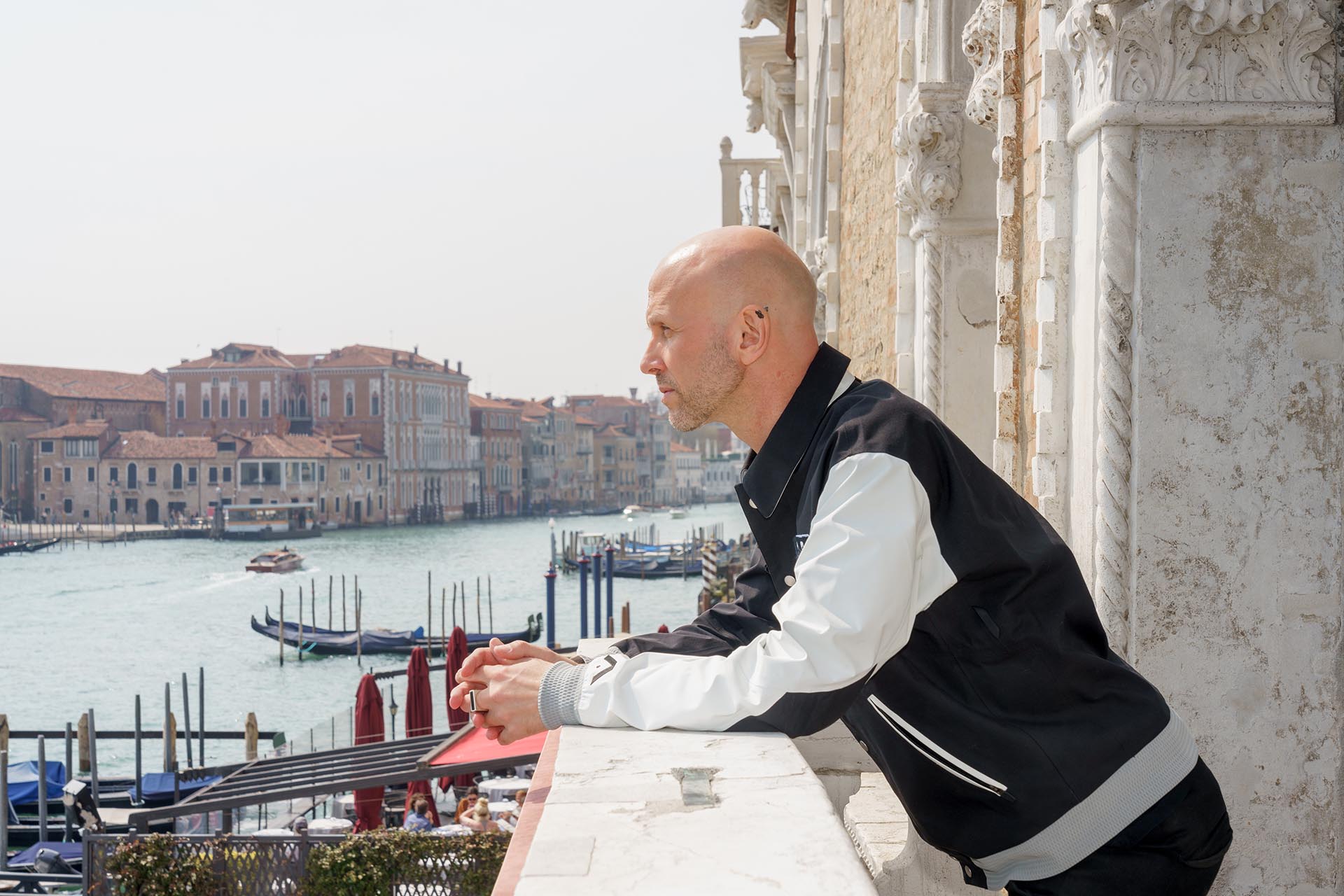

One of the world’s most acclaimed choreographers, Wayne McGregor, directing his third edition of the Biennale Danza, Altered States, talks about himself and reveals his vision of dance.
Now at his third year at the helm of the Dance Biennale, Wayne McGregor is the author of the choreographies for the Harry Potter film series and The Legend of Tarzan, among others. He also designed choreographies for the latest Abba show and projects for a ‘real-world metaverse’. In 1992, he founded Random Dance, later renamed after himself, and is a professor at the Trinity Laban Conservatoire. At time of writing, McGregor is at the London Royal Opera with A Dark Crystal Odyssey, a piece on climate crisis and environmental destruction. On the last May 8, his 17th International Dance Festival, titled Altered States, began. We’ll try to understand his way of thinking a bit better.
You seem to be interested in body and motion, the body learning from the senses and incorporating the past. Does cognitive psychology play a role in this?
What you talking about is embodied cognition, right? How the feedback loop between the body and the brain works, and how our cognitive habits are formed. The dancer is a performer, but also, performers have cognitive habits. They solve creative problems, often in the same kind of way anyone else does. We worked with cognitive neuroscientists from Cambridge who helped us understand how the individual dancers were forming habits, and offered them an opportunity to work in a different way. This kind of perturbation, this kind of disruption of normal cognitive pathways allow us to reengage with the body in a different way, which is really interesting. Right now, you’re solving a physical problem in a different way: a new language emerges. I’m really fascinated by this: how is it that the brain normalises and makes patterns from certain behaviours? And how might we be able to disrupt those behaviours to get new patterns, and therefore get new modes of physical moving?
So, for example, we’ve built this system with those neuroscientists, it’s called mind and movement and it’s a project that was supported by the Welcome Trust in London. This project is a teaching tool, effectively. For example, when you’re thinking about dance, you think about visual images, right? We know some people solve physical problems visually, but is there such a thing as an acoustic image? What is a kinaesthetic image? What are the properties of those and how do we practise them if we’re more used to working in a visual domain? If we now think about acoustic images, so these sound images, how do you build a whole range of techniques to access them bypassing our visual system? It’s a different way to navigate a different kind of territory. Obviously, we need some brilliant cognitive neuroscientists to help us do that, but we’re scratching the surface of this possibility. We understand there’s a whole range of options that we never access, and if we can access them, that’s extraordinary.
How do you go about this process? How to start designing a new piece of dance?
Well, it’s not very linear, that’s the first thing. I start projects many, many years in advance, so it feels like I have a lot of ideas, all percolating at the. time, and then, all of a sudden, one takes off or becomes essential. You can probably draw a parallel with writing. It’s the same right. I take notes. I’ve just digitised all of my archive, which includes all my choreographic notebooks, and I had them analysed by cognitive neuroscientists at Cambridge, again to see what are the ways in which I use my notebook for thinking. How do I think with a notebook, what do I use it for? What was interesting is that they came back to me to say: you don’t think anything choreographic with the notebook, because that’s your skill in the studio. You don’t need to write that down, anything else you write in the notebooks is rather conceptual ideas or strains of information. They’re essential to the process, but they’re not choreographic structures, and that’s interesting. Therefore, when you think about where an idea starts, you’ll know an idea starts way, way before you get into the studio. I have a system in London. It’s called the smart studio, which captures my process with six cameras. Again, we’ve had that analysed by cognitive neuroscientists in San Diego, where they were looking at where the decisions change. Which is to say, not analysing what is the thing that you’re making, but where does an idea move from one to the other.
Dancers perhaps have different biases in terms of what it is that they contribute to a process. And you need a range of people with certain kinds of talent to make that remembering process effective. That is super interesting to me. We capture all of that and then when I’m making a ballet, I have a notator. We’re just restaging our Dante project now for the Paris Opera, which will also be drafted by a notator. In combination, these things build a rich picture. In isolation, they do have lots of limitations; cumulatively, they have more power.

Your work seems to have very few limits, as it stands. You worked with motion as well as sound, colour, and perfumes.
I mentioned visual images, acoustic image, kinaesthetic images, olfactory image earlier. Those really powerful, right? I did a little experiment with Joe Malone. We made a Swan Lake exhibition in London at the Opera House, through smell only. We have the choreographic journey as to olfactory image. That was a really lovely experiment, but it’s very difficult. It’s very difficult to work in that way. There’s a new venue in London called the Sphere, which is a brilliant system that can send different audio streams to each visitor. 20,000 people can have different sound relationships with the show. They’re pioneering that same technology for smell, so that you can direct an olfactory stimulant to one person and a different one to another. You might smell cut grass and you might smell burning fire. And that’s very interesting. How we can build an environment where visual, sonic, and olfactory experience are opposed to the person next to you? We always talk about dance being a collective experience, which of course it is, but we don’t experience the same things in the same way, anyway! This just highlights that, and I’m very interested to see what that technology will be.
There’s a whole range of options that we never access, and if we can access them, that’s extraordinary…
How important it is to understand the meaning of a choreography?
Good question. I think we’ve been pushed into describing meaning in words and retrospectively analysing work, looking back and saying ‘this word means this’ and therefore you should see this. I’m very much more of a believer in the need to interact and notice your senses, and in doing that, when you audit your senses, meaning emerges rather than the other way, where you have a rational idea about what the meaning is. ‘This means X and you try and find it in the work’. They’re both valid ways, they’re just different, and I just think there’s too much obsession in dance with concreteness, with specificity, in terms of meaning, whereas we know that dance is slippery and ambiguous, and it connects with us in lots of different ways. And we should celebrate that. You know, why do we have to pin it down by going X = X I don’t need to tell you all of my research unless you’re interested in it, for you to look for that specific thing in there. What I want you to do is to experience the work and think: this is how this moves me or makes me feel or reminds me of, and you build the meaning for it.
I think a lot of early audiences who don’t see a lot of dance worry that they’re not going to get it. “We don’t get it”. And I think it’s partly our fault that we kind of say to them “You should get it”. This expert language in ballet means this, and you should know it. And if you don’t know, that excludes you and actually, what we should be saying is: “Go see Swan Lake. What do you see? What do you notice?”. When you do that with eight-year-olds, they’re so freer, they see so much, and that’s the kind of playful curiosity you want to encourage an audience. I hope in this festival the audiences will look with that playful curiosity.
Interview with Andrea Peña, choreographer, dancer and designer, guest of the 17. Dance Biennale